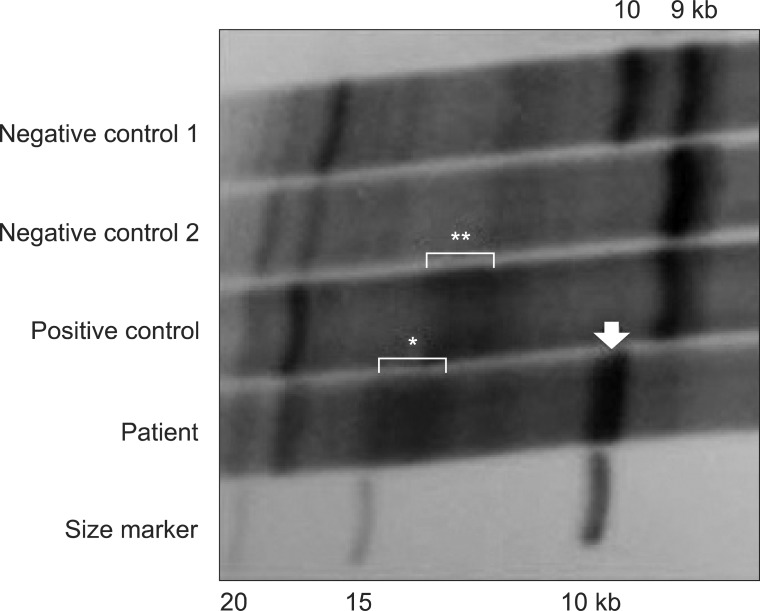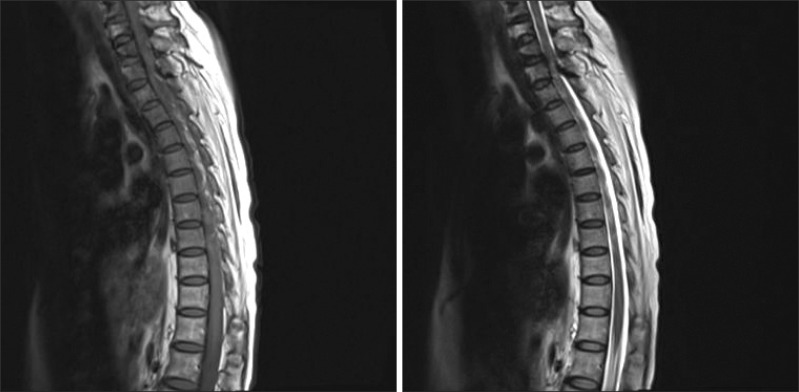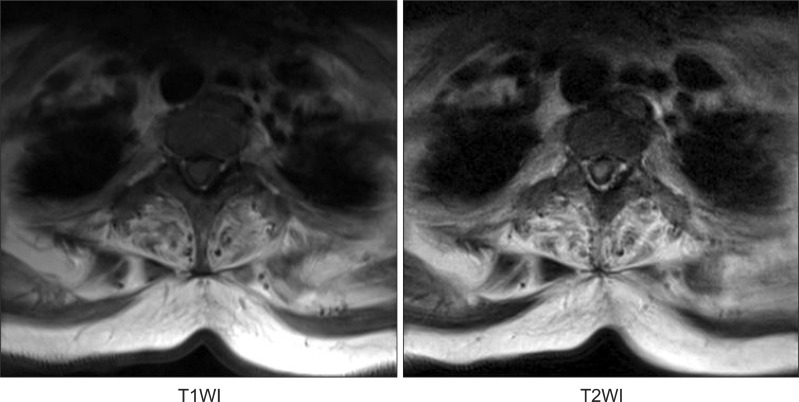Ann Rehabil Med.
2012 Aug;36(4):569-572. 10.5535/arm.2012.36.4.569.
Upper Thoracic Myelopathy Caused by Delayed Neck Extensor Weakness in Myotonic Dystrophy
- Affiliations
-
- 1Department of Rehabilitation Medicine, Pusan National University School of Medicine, Busan 602-739, Korea. yi0314@gmail.com
- 2Department of Laboratory Medicine & Genetics, Samsung Medical Center, Sungkyunkwan University School of Medicine, Seoul 135-710, Korea.
- KMID: 2266731
- DOI: http://doi.org/10.5535/arm.2012.36.4.569
Abstract
- Myotonic dystrophy is the most common autosomal dominant myopathy in adults. Our patient, a 41 year-old female suffering from myotonic muscular dystrophy, developed upper thoracic myelopathy due to hypertrophy of the ligamentum flavum and the posterior longitudinal ligament. She had a typical hatchet face and ptosis with "head hanging forward" appearance caused by neck weakness. Motor weakness, sensory changes and severe pain below T4 level, along with urinary incontinence began 3 months ago. Genetic and electrodiagnostic studies revealed myotonic dystrophy type 1. Magnetic resonance imaging of the spine showed loss of cervical lordosis and spinal cord compression due to hypertrophied ligamentum flavum and posterior longitudinal ligament at T1 to T3 level. We concluded that her upper thoracic myelopathy was likely related to the thickness of the ligamentum flavum and posterior longitudinal ligament due to repetitive mechanical stress on her neck caused by neck muscle weakness with myotonic dystrophy.
MeSH Terms
Figure
Reference
-
1. Cho DH, Tapscott SJ. Myotonic dystrophy: emerging mechanisms for DM1 and DM2. Biochim Biophys Acta. 2007; 1772:195–204. PMID: 16876389.
Article2. Turner C, Hilton-Jones D. The myotonic dystrophies: diagnosis and management. J Neurol Neurosurg Psychiatry. 2010; 81:358–367. PMID: 20176601.
Article3. Goh KJ, Wong KT, Tan CT. Myopathic dropped head syndrome: a syndrome of mixed aetiology. J Clin Neurosci. 2000; 7:334–336. PMID: 10938615.
Article4. Uchida K, Nakajima H, Sato R, Yayama T, Mwaka ES, Kobayashi S, Baba H. Cervical spondylotic myelopathy associated with kyphosis or sagittal sigmoid alignment: outcome after anterior or posterior decompression. J Neurosurg Spine. 2009; 11:521–528. PMID: 19929353.
Article5. Nakanishi K, Taneda M, Sumii T, Yabuuchi T, Iwakura N. Cervical myelopathy caused by dropped head syndrome. Case report and review of the literature. J Neurosurg Spine. 2007; 6:165–116. PMID: 17330586.6. Jayakumar PN, Devi BI, Bhat DI, Das BS. Thoracic cord compression due to ossified hypertrophied ligamentum flavum. Neurol India. 2002; 50:286–289. PMID: 12391454.7. Giulioni M, Zucchelli M, Damiani S. Thoracic myelopathy caused by calcified ligamentum flavum. Joint Bone Spine. 2007; 74:504–505. PMID: 17709270.
Article8. Al-Orainy IA, Kolawole T. Ossification of the ligament flavum. Eur J Radiol. 1998; 29:76–82. PMID: 9934562.
Article9. Guo JJ, Luk KD, Karppinen J, Yang H, Cheung KM. Prevalence, distribution, and morphology of ossification of the ligamentum flavum: a population study of one thousand seven hundred thirty-six magnetic resonance imaging scans. Spine (Phila Pa 1976). 2010; 35:51–56. PMID: 20042956.
- Full Text Links
- Actions
-
Cited
- CITED
-
- Close
- Share
- Similar articles
-
- Myotonic Dystrophy (A case report)
- Two Cases of Cataract in Two Sisters with Myotonic Dystrophy
- Myotonic Dystrophy Coexisting with Thymoma: Successful Treatment with Video Assisted Thoracoscopic Surgery
- Respiratory failure due to myotonic dystrophy combined with peripartum cardiomyopathy: A case report
- Radiofrequency Catheter Ablation of Persistent Atrial Fibrillation with Myotonic Dystrophy and Achalasia-like Esophageal Dilatation




